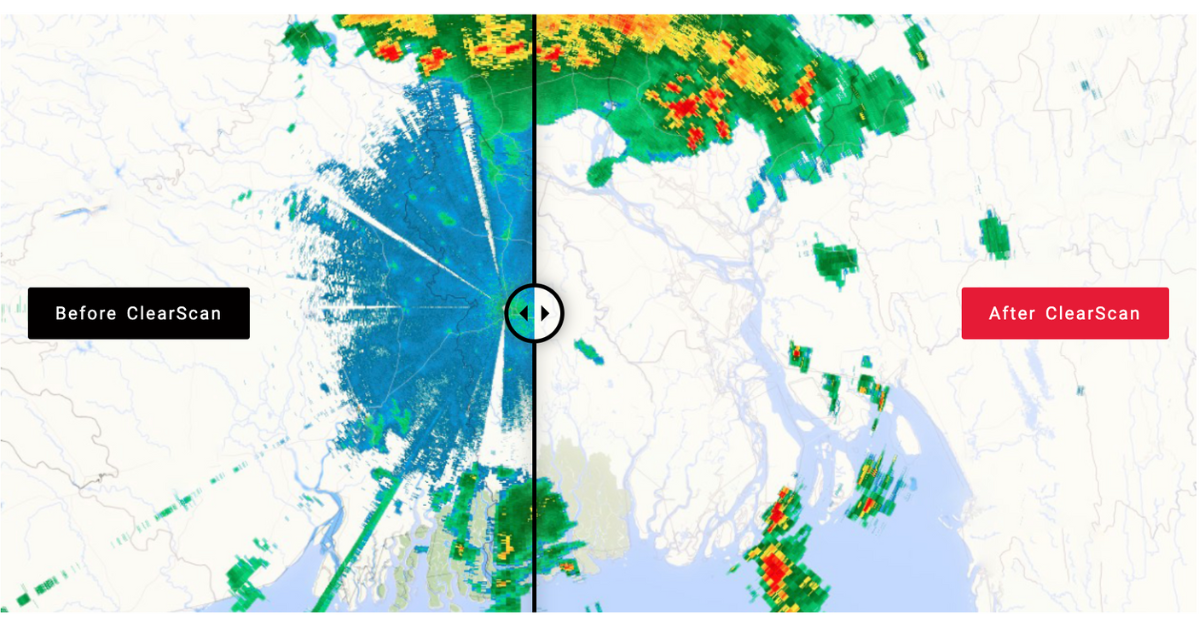Baron’s machine learning clutter mitigation technology, ClearScan™, made its debut in the spring of 2022. ClearScan learns and removes extraneous returns or “noise” from radar returns and provides the user with precipitation data with unmatched clarity. Using machine learning algorithms supported by human intervention, Baron ClearScan learns to recognize data from actual weather targets versus radio frequency interference (RF) or anomalous propagation (AP).
The image comparison below reveals the difference ClearScan makes in radar quality and clarity.

Recently, we sat down with the creator of ClearScan and a few of our scientists and meteorologists to answer your ClearScan FAQ's about the technology. Here are their answers.
What was the impetus to develop ClearScan?
Our customers were voicing a growing concern as new technologies like 5G cellular signals have increased interference with weather radars, especially C-Band weather radars.
“They needed a solution that could remove the noise from interference and other anomalous phenomena and improve the quality of their radar data,” says Erick Jones, lead software engineer and the creator who developed the application. “Baron wanted to solve these operational challenges.”
“We’ve always been a leader in weather radar innovation,” he says. “This tool, ultimately, has led to more accurate and reliable weather detection and forecasting.”
What makes ClearScan so unique?
The exclusive ClearScan technology examines reflectivity and dual-polarization data to understand the difference between quality radar data and anomalous propagation (AP) or radio frequency (RF) interference. “Baron’s ClearScan is able to recognize AP or RF, then remove it from a dual-polarization radar data display instantaneously,” says Erick. “We can tailor the technology to solve interference challenges that are unique to specific media markets.”
What if a new interference shows up and machine learning doesn’t remove it?
ClearScan allows us to highlight new interference, so the technology learns. While we don’t know what future interference will “look” like, currently, we work with our customers, using their unique radar data to train the network. We train the filters, so the information it delivers is fine-tuned.
Can ClearScan be used on any radar? Does it add any delay to the data display?
According to Baron Weather Chief Development Officer, Sherman Wilcox, “There’s no delay in processing and it’s done immediately by downstream computers that are very quick, so it’s instantly applied.” A Baron radar with dual-pol capability is required.
Do you apply your corrections to volume data or ground composite data?
We leave the original data alone and output a new volume of data (radial form) that has been repaired.
According to Baron Meteorologist and Global Business Development Manager, Brian Bellew, “If you are doing a volumetric scan, the reflectivity is massaged by machine learning so the data technique can be applied at any tilt level and it is applied to reflectivity only at this point. No matter the scan strategy, machine learning will be applied on each level scanned any way you execute your scan strategy.”
When it comes to experiences with coastal radar, do you have problems with bridge echoes or airplanes?
Those types of obstacles do not prevent clean-up and we've applied ClearScan to coastal radars. Our CleanAP was designed to remove static objects such as buildings and so forth.
Bridge echoes are unique – not because of the bridge, which can be easily removed because it’s a static object.
“The issue tends to be the moving vehicles on bridges; since they’re moving objects, much like you’d find in the atmosphere,” according to Brian. “The method we use in machine learning doesn’t just use reflectivity, it uses other dual-pol moments to identify the actual return – whether it is an atmosphere particulate or not. Knowing the process, it could identify car versus an actual atmospheric particulate or hydrometeor.”
Do you see the technology changing within the next few years?
Baron has a history of defining the latest weather innovations. It’s part of our core culture and mission to always improve our data and technology.
As Sherman points out, “At this point, there aren’t any current plans to modify the core algorithm. We’re very happy with its performance. But when it comes to pushing past the head of the curve, Baron’s people are relentless. So, whatever the future brings, I’m confident we’ll meet that challenge head-on.”
Do you have a question regarding ClearScan you’d like to see us answer? Please let one of our experts know and they will reach out.
Do you have a question regarding ClearScan you’d like to see us answer? Please let one of our experts know and they will reach out.
Talk to an Expert